Exploring the Paradigm Wars in Organization Theory
VerifiedAdded on 2022/11/11
|9
|3205
|359
AI Summary
This essay analyzes deterministic and strategic choice theories in organization theory, their contributions to organizational success, and identifies the best theory. The essay provides a critical analysis of the theories and their applications in organizations. It also highlights the importance of maintaining interrelationships between employers and employees, resource management, and the importance of policies in organizations.
Contribute Materials
Your contribution can guide someone’s learning journey. Share your
documents today.
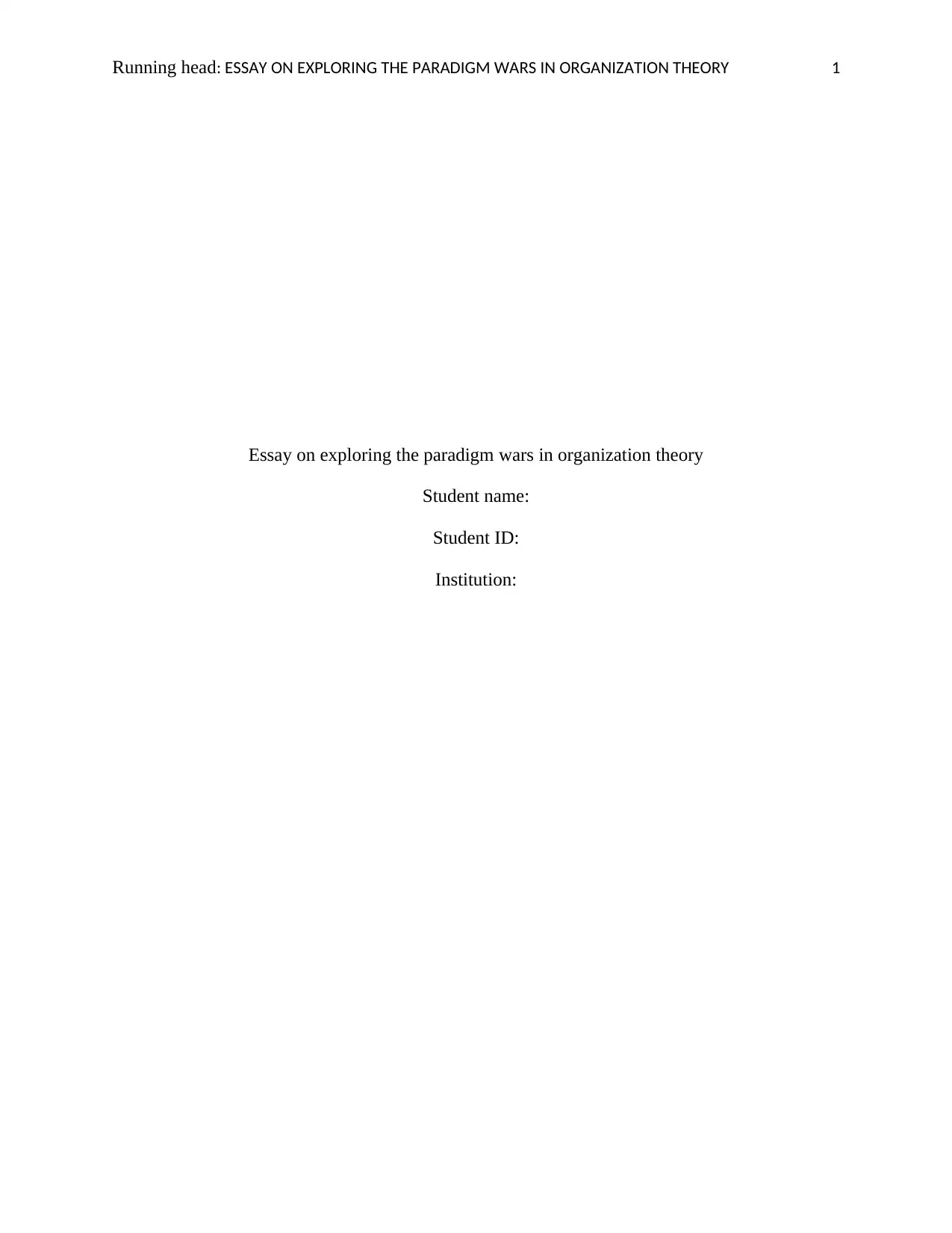
Running head: ESSAY ON EXPLORING THE PARADIGM WARS IN ORGANIZATION THEORY 1
Essay on exploring the paradigm wars in organization theory
Student name:
Student ID:
Institution:
Essay on exploring the paradigm wars in organization theory
Student name:
Student ID:
Institution:
Secure Best Marks with AI Grader
Need help grading? Try our AI Grader for instant feedback on your assignments.
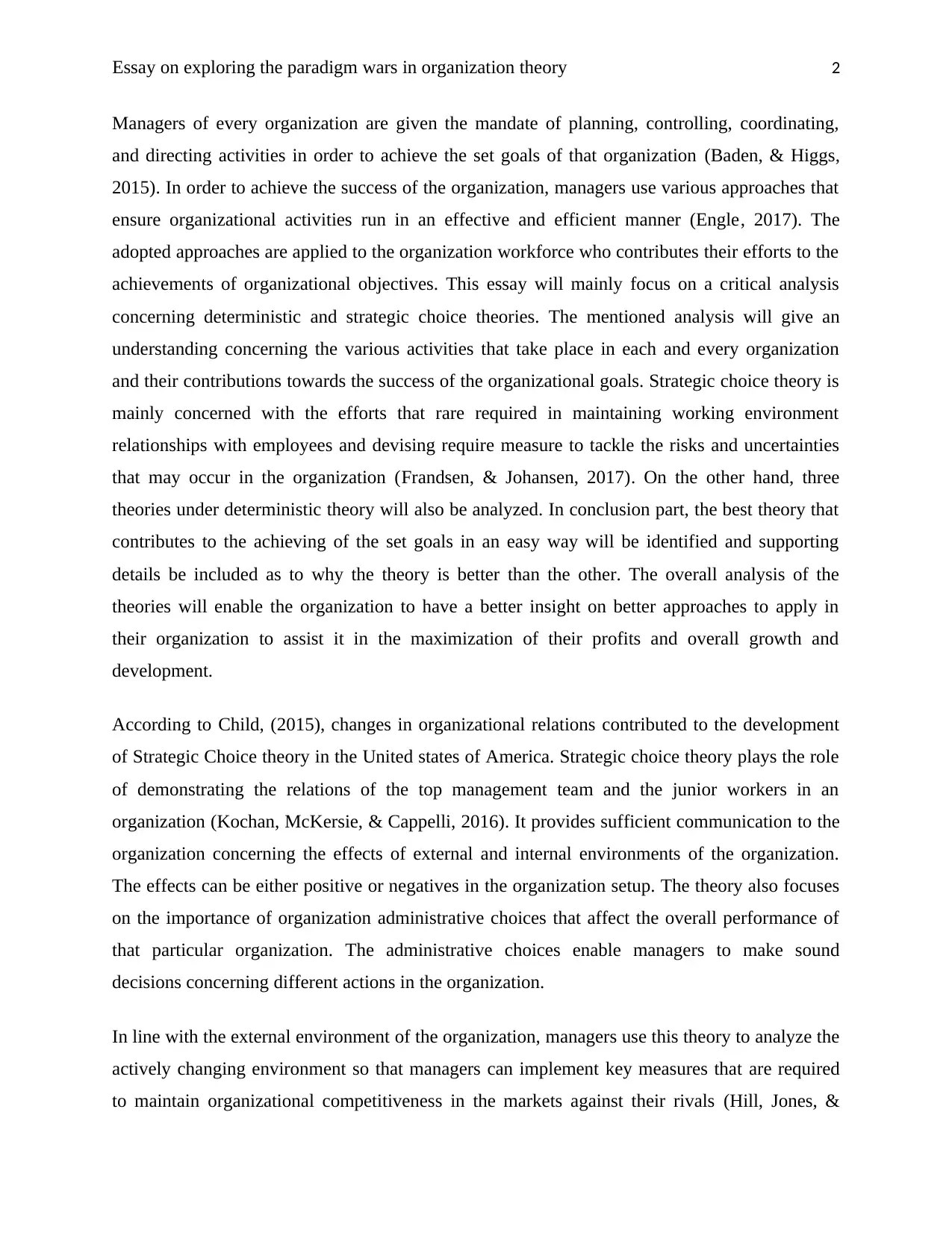
Essay on exploring the paradigm wars in organization theory 2
Managers of every organization are given the mandate of planning, controlling, coordinating,
and directing activities in order to achieve the set goals of that organization (Baden, & Higgs,
2015). In order to achieve the success of the organization, managers use various approaches that
ensure organizational activities run in an effective and efficient manner (Engle, 2017). The
adopted approaches are applied to the organization workforce who contributes their efforts to the
achievements of organizational objectives. This essay will mainly focus on a critical analysis
concerning deterministic and strategic choice theories. The mentioned analysis will give an
understanding concerning the various activities that take place in each and every organization
and their contributions towards the success of the organizational goals. Strategic choice theory is
mainly concerned with the efforts that rare required in maintaining working environment
relationships with employees and devising require measure to tackle the risks and uncertainties
that may occur in the organization (Frandsen, & Johansen, 2017). On the other hand, three
theories under deterministic theory will also be analyzed. In conclusion part, the best theory that
contributes to the achieving of the set goals in an easy way will be identified and supporting
details be included as to why the theory is better than the other. The overall analysis of the
theories will enable the organization to have a better insight on better approaches to apply in
their organization to assist it in the maximization of their profits and overall growth and
development.
According to Child, (2015), changes in organizational relations contributed to the development
of Strategic Choice theory in the United states of America. Strategic choice theory plays the role
of demonstrating the relations of the top management team and the junior workers in an
organization (Kochan, McKersie, & Cappelli, 2016). It provides sufficient communication to the
organization concerning the effects of external and internal environments of the organization.
The effects can be either positive or negatives in the organization setup. The theory also focuses
on the importance of organization administrative choices that affect the overall performance of
that particular organization. The administrative choices enable managers to make sound
decisions concerning different actions in the organization.
In line with the external environment of the organization, managers use this theory to analyze the
actively changing environment so that managers can implement key measures that are required
to maintain organizational competitiveness in the markets against their rivals (Hill, Jones, &
Managers of every organization are given the mandate of planning, controlling, coordinating,
and directing activities in order to achieve the set goals of that organization (Baden, & Higgs,
2015). In order to achieve the success of the organization, managers use various approaches that
ensure organizational activities run in an effective and efficient manner (Engle, 2017). The
adopted approaches are applied to the organization workforce who contributes their efforts to the
achievements of organizational objectives. This essay will mainly focus on a critical analysis
concerning deterministic and strategic choice theories. The mentioned analysis will give an
understanding concerning the various activities that take place in each and every organization
and their contributions towards the success of the organizational goals. Strategic choice theory is
mainly concerned with the efforts that rare required in maintaining working environment
relationships with employees and devising require measure to tackle the risks and uncertainties
that may occur in the organization (Frandsen, & Johansen, 2017). On the other hand, three
theories under deterministic theory will also be analyzed. In conclusion part, the best theory that
contributes to the achieving of the set goals in an easy way will be identified and supporting
details be included as to why the theory is better than the other. The overall analysis of the
theories will enable the organization to have a better insight on better approaches to apply in
their organization to assist it in the maximization of their profits and overall growth and
development.
According to Child, (2015), changes in organizational relations contributed to the development
of Strategic Choice theory in the United states of America. Strategic choice theory plays the role
of demonstrating the relations of the top management team and the junior workers in an
organization (Kochan, McKersie, & Cappelli, 2016). It provides sufficient communication to the
organization concerning the effects of external and internal environments of the organization.
The effects can be either positive or negatives in the organization setup. The theory also focuses
on the importance of organization administrative choices that affect the overall performance of
that particular organization. The administrative choices enable managers to make sound
decisions concerning different actions in the organization.
In line with the external environment of the organization, managers use this theory to analyze the
actively changing environment so that managers can implement key measures that are required
to maintain organizational competitiveness in the markets against their rivals (Hill, Jones, &
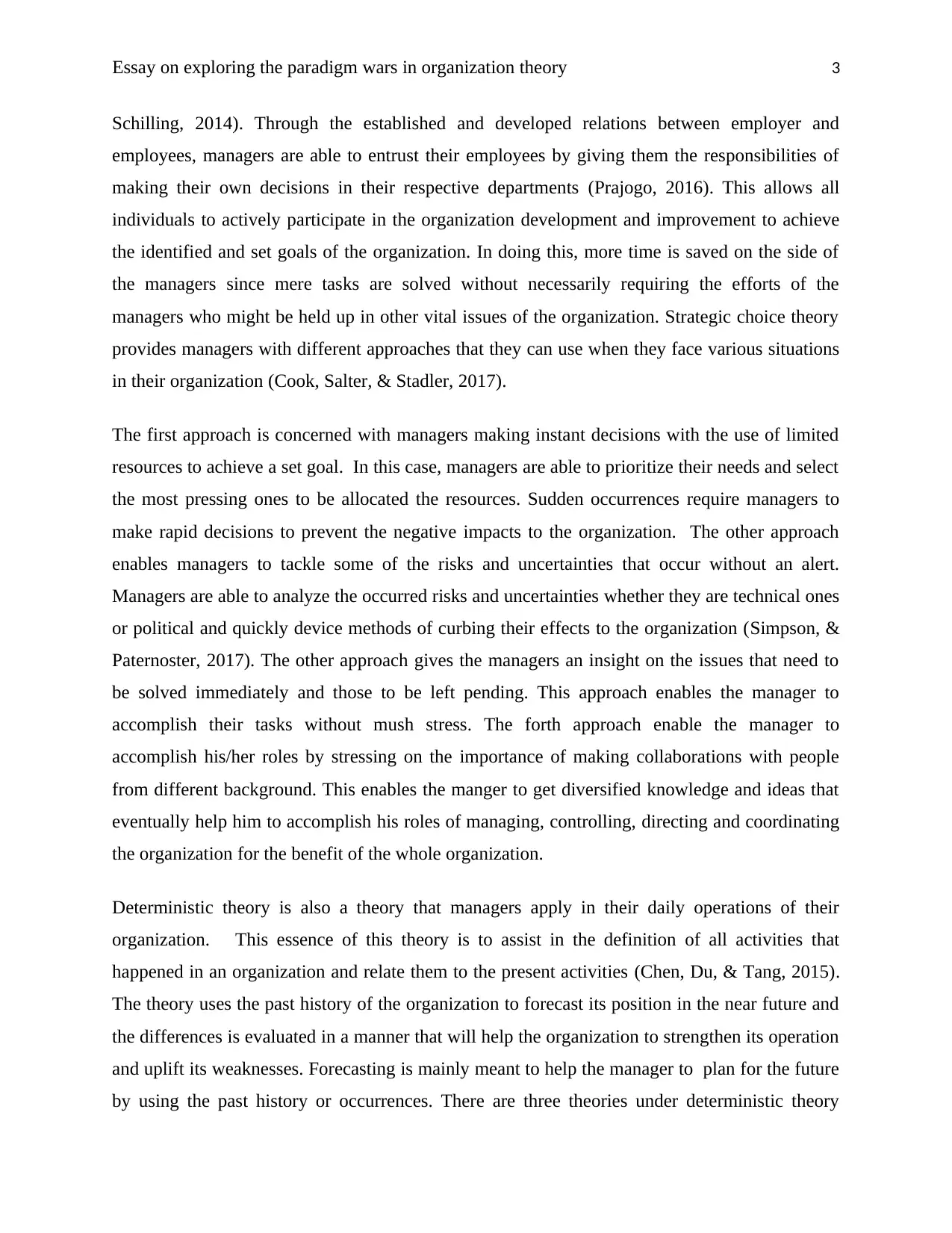
Essay on exploring the paradigm wars in organization theory 3
Schilling, 2014). Through the established and developed relations between employer and
employees, managers are able to entrust their employees by giving them the responsibilities of
making their own decisions in their respective departments (Prajogo, 2016). This allows all
individuals to actively participate in the organization development and improvement to achieve
the identified and set goals of the organization. In doing this, more time is saved on the side of
the managers since mere tasks are solved without necessarily requiring the efforts of the
managers who might be held up in other vital issues of the organization. Strategic choice theory
provides managers with different approaches that they can use when they face various situations
in their organization (Cook, Salter, & Stadler, 2017).
The first approach is concerned with managers making instant decisions with the use of limited
resources to achieve a set goal. In this case, managers are able to prioritize their needs and select
the most pressing ones to be allocated the resources. Sudden occurrences require managers to
make rapid decisions to prevent the negative impacts to the organization. The other approach
enables managers to tackle some of the risks and uncertainties that occur without an alert.
Managers are able to analyze the occurred risks and uncertainties whether they are technical ones
or political and quickly device methods of curbing their effects to the organization (Simpson, &
Paternoster, 2017). The other approach gives the managers an insight on the issues that need to
be solved immediately and those to be left pending. This approach enables the manager to
accomplish their tasks without mush stress. The forth approach enable the manager to
accomplish his/her roles by stressing on the importance of making collaborations with people
from different background. This enables the manger to get diversified knowledge and ideas that
eventually help him to accomplish his roles of managing, controlling, directing and coordinating
the organization for the benefit of the whole organization.
Deterministic theory is also a theory that managers apply in their daily operations of their
organization. This essence of this theory is to assist in the definition of all activities that
happened in an organization and relate them to the present activities (Chen, Du, & Tang, 2015).
The theory uses the past history of the organization to forecast its position in the near future and
the differences is evaluated in a manner that will help the organization to strengthen its operation
and uplift its weaknesses. Forecasting is mainly meant to help the manager to plan for the future
by using the past history or occurrences. There are three theories under deterministic theory
Schilling, 2014). Through the established and developed relations between employer and
employees, managers are able to entrust their employees by giving them the responsibilities of
making their own decisions in their respective departments (Prajogo, 2016). This allows all
individuals to actively participate in the organization development and improvement to achieve
the identified and set goals of the organization. In doing this, more time is saved on the side of
the managers since mere tasks are solved without necessarily requiring the efforts of the
managers who might be held up in other vital issues of the organization. Strategic choice theory
provides managers with different approaches that they can use when they face various situations
in their organization (Cook, Salter, & Stadler, 2017).
The first approach is concerned with managers making instant decisions with the use of limited
resources to achieve a set goal. In this case, managers are able to prioritize their needs and select
the most pressing ones to be allocated the resources. Sudden occurrences require managers to
make rapid decisions to prevent the negative impacts to the organization. The other approach
enables managers to tackle some of the risks and uncertainties that occur without an alert.
Managers are able to analyze the occurred risks and uncertainties whether they are technical ones
or political and quickly device methods of curbing their effects to the organization (Simpson, &
Paternoster, 2017). The other approach gives the managers an insight on the issues that need to
be solved immediately and those to be left pending. This approach enables the manager to
accomplish their tasks without mush stress. The forth approach enable the manager to
accomplish his/her roles by stressing on the importance of making collaborations with people
from different background. This enables the manger to get diversified knowledge and ideas that
eventually help him to accomplish his roles of managing, controlling, directing and coordinating
the organization for the benefit of the whole organization.
Deterministic theory is also a theory that managers apply in their daily operations of their
organization. This essence of this theory is to assist in the definition of all activities that
happened in an organization and relate them to the present activities (Chen, Du, & Tang, 2015).
The theory uses the past history of the organization to forecast its position in the near future and
the differences is evaluated in a manner that will help the organization to strengthen its operation
and uplift its weaknesses. Forecasting is mainly meant to help the manager to plan for the future
by using the past history or occurrences. There are three theories under deterministic theory
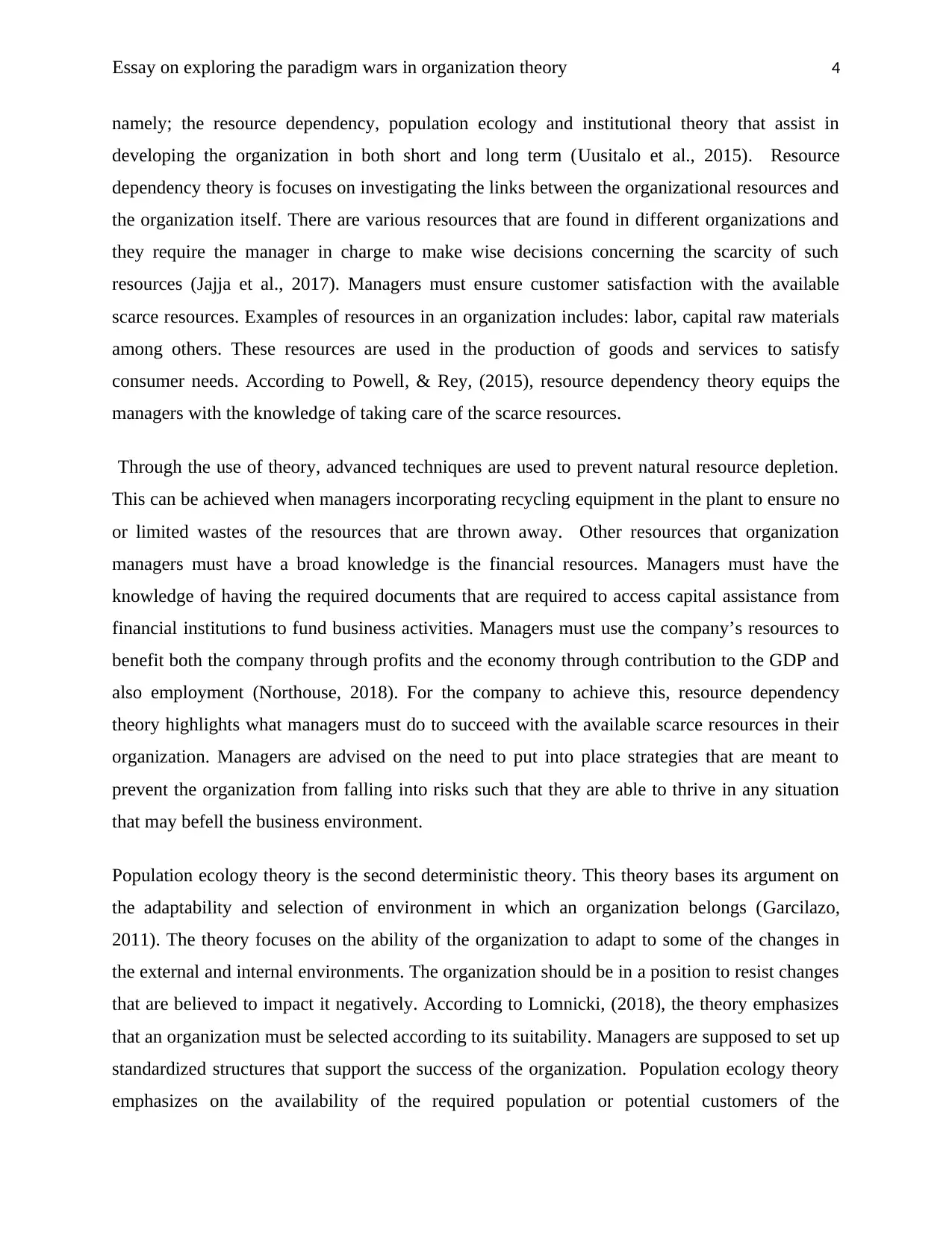
Essay on exploring the paradigm wars in organization theory 4
namely; the resource dependency, population ecology and institutional theory that assist in
developing the organization in both short and long term (Uusitalo et al., 2015). Resource
dependency theory is focuses on investigating the links between the organizational resources and
the organization itself. There are various resources that are found in different organizations and
they require the manager in charge to make wise decisions concerning the scarcity of such
resources (Jajja et al., 2017). Managers must ensure customer satisfaction with the available
scarce resources. Examples of resources in an organization includes: labor, capital raw materials
among others. These resources are used in the production of goods and services to satisfy
consumer needs. According to Powell, & Rey, (2015), resource dependency theory equips the
managers with the knowledge of taking care of the scarce resources.
Through the use of theory, advanced techniques are used to prevent natural resource depletion.
This can be achieved when managers incorporating recycling equipment in the plant to ensure no
or limited wastes of the resources that are thrown away. Other resources that organization
managers must have a broad knowledge is the financial resources. Managers must have the
knowledge of having the required documents that are required to access capital assistance from
financial institutions to fund business activities. Managers must use the company’s resources to
benefit both the company through profits and the economy through contribution to the GDP and
also employment (Northouse, 2018). For the company to achieve this, resource dependency
theory highlights what managers must do to succeed with the available scarce resources in their
organization. Managers are advised on the need to put into place strategies that are meant to
prevent the organization from falling into risks such that they are able to thrive in any situation
that may befell the business environment.
Population ecology theory is the second deterministic theory. This theory bases its argument on
the adaptability and selection of environment in which an organization belongs (Garcilazo,
2011). The theory focuses on the ability of the organization to adapt to some of the changes in
the external and internal environments. The organization should be in a position to resist changes
that are believed to impact it negatively. According to Lomnicki, (2018), the theory emphasizes
that an organization must be selected according to its suitability. Managers are supposed to set up
standardized structures that support the success of the organization. Population ecology theory
emphasizes on the availability of the required population or potential customers of the
namely; the resource dependency, population ecology and institutional theory that assist in
developing the organization in both short and long term (Uusitalo et al., 2015). Resource
dependency theory is focuses on investigating the links between the organizational resources and
the organization itself. There are various resources that are found in different organizations and
they require the manager in charge to make wise decisions concerning the scarcity of such
resources (Jajja et al., 2017). Managers must ensure customer satisfaction with the available
scarce resources. Examples of resources in an organization includes: labor, capital raw materials
among others. These resources are used in the production of goods and services to satisfy
consumer needs. According to Powell, & Rey, (2015), resource dependency theory equips the
managers with the knowledge of taking care of the scarce resources.
Through the use of theory, advanced techniques are used to prevent natural resource depletion.
This can be achieved when managers incorporating recycling equipment in the plant to ensure no
or limited wastes of the resources that are thrown away. Other resources that organization
managers must have a broad knowledge is the financial resources. Managers must have the
knowledge of having the required documents that are required to access capital assistance from
financial institutions to fund business activities. Managers must use the company’s resources to
benefit both the company through profits and the economy through contribution to the GDP and
also employment (Northouse, 2018). For the company to achieve this, resource dependency
theory highlights what managers must do to succeed with the available scarce resources in their
organization. Managers are advised on the need to put into place strategies that are meant to
prevent the organization from falling into risks such that they are able to thrive in any situation
that may befell the business environment.
Population ecology theory is the second deterministic theory. This theory bases its argument on
the adaptability and selection of environment in which an organization belongs (Garcilazo,
2011). The theory focuses on the ability of the organization to adapt to some of the changes in
the external and internal environments. The organization should be in a position to resist changes
that are believed to impact it negatively. According to Lomnicki, (2018), the theory emphasizes
that an organization must be selected according to its suitability. Managers are supposed to set up
standardized structures that support the success of the organization. Population ecology theory
emphasizes on the availability of the required population or potential customers of the
Secure Best Marks with AI Grader
Need help grading? Try our AI Grader for instant feedback on your assignments.
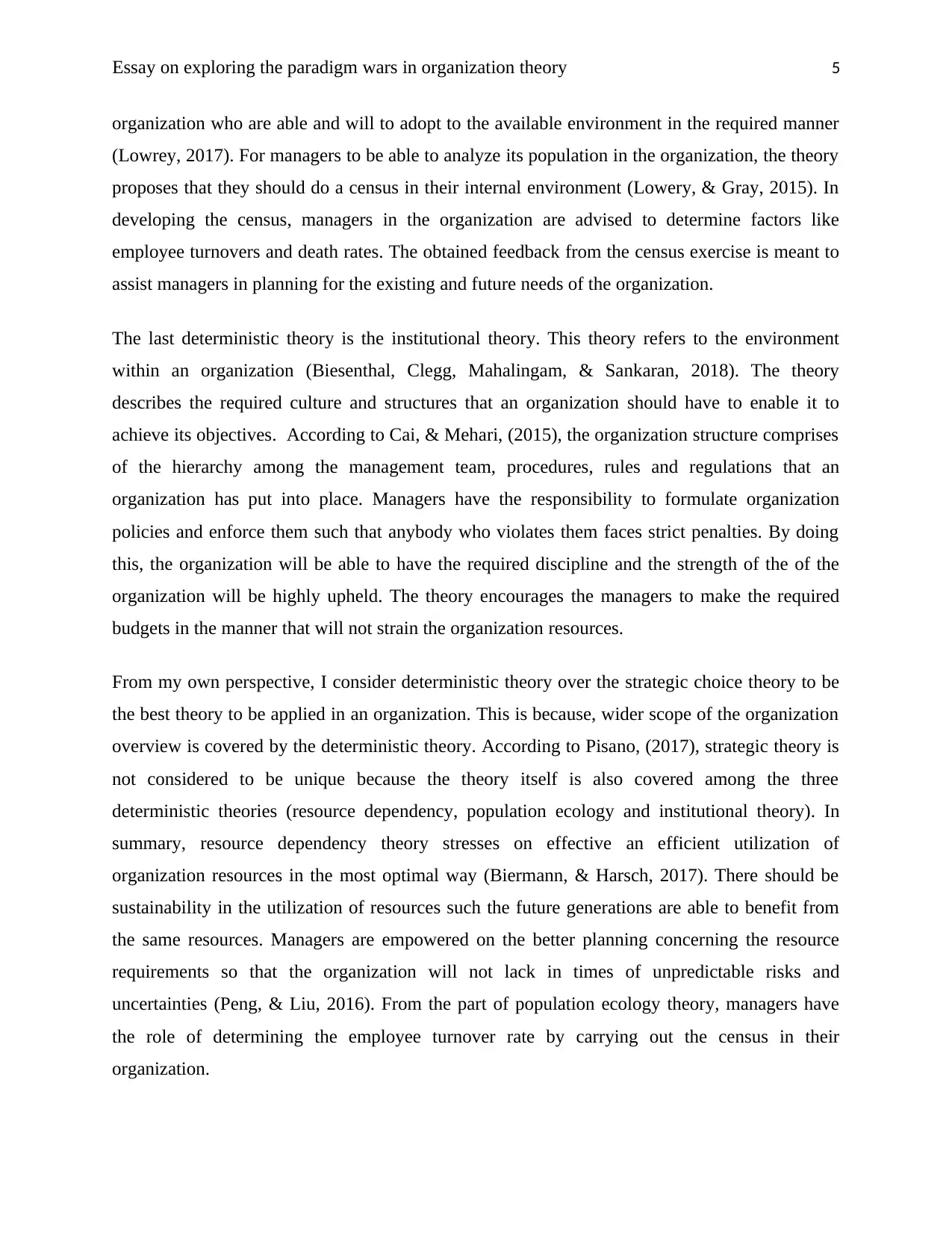
Essay on exploring the paradigm wars in organization theory 5
organization who are able and will to adopt to the available environment in the required manner
(Lowrey, 2017). For managers to be able to analyze its population in the organization, the theory
proposes that they should do a census in their internal environment (Lowery, & Gray, 2015). In
developing the census, managers in the organization are advised to determine factors like
employee turnovers and death rates. The obtained feedback from the census exercise is meant to
assist managers in planning for the existing and future needs of the organization.
The last deterministic theory is the institutional theory. This theory refers to the environment
within an organization (Biesenthal, Clegg, Mahalingam, & Sankaran, 2018). The theory
describes the required culture and structures that an organization should have to enable it to
achieve its objectives. According to Cai, & Mehari, (2015), the organization structure comprises
of the hierarchy among the management team, procedures, rules and regulations that an
organization has put into place. Managers have the responsibility to formulate organization
policies and enforce them such that anybody who violates them faces strict penalties. By doing
this, the organization will be able to have the required discipline and the strength of the of the
organization will be highly upheld. The theory encourages the managers to make the required
budgets in the manner that will not strain the organization resources.
From my own perspective, I consider deterministic theory over the strategic choice theory to be
the best theory to be applied in an organization. This is because, wider scope of the organization
overview is covered by the deterministic theory. According to Pisano, (2017), strategic theory is
not considered to be unique because the theory itself is also covered among the three
deterministic theories (resource dependency, population ecology and institutional theory). In
summary, resource dependency theory stresses on effective an efficient utilization of
organization resources in the most optimal way (Biermann, & Harsch, 2017). There should be
sustainability in the utilization of resources such the future generations are able to benefit from
the same resources. Managers are empowered on the better planning concerning the resource
requirements so that the organization will not lack in times of unpredictable risks and
uncertainties (Peng, & Liu, 2016). From the part of population ecology theory, managers have
the role of determining the employee turnover rate by carrying out the census in their
organization.
organization who are able and will to adopt to the available environment in the required manner
(Lowrey, 2017). For managers to be able to analyze its population in the organization, the theory
proposes that they should do a census in their internal environment (Lowery, & Gray, 2015). In
developing the census, managers in the organization are advised to determine factors like
employee turnovers and death rates. The obtained feedback from the census exercise is meant to
assist managers in planning for the existing and future needs of the organization.
The last deterministic theory is the institutional theory. This theory refers to the environment
within an organization (Biesenthal, Clegg, Mahalingam, & Sankaran, 2018). The theory
describes the required culture and structures that an organization should have to enable it to
achieve its objectives. According to Cai, & Mehari, (2015), the organization structure comprises
of the hierarchy among the management team, procedures, rules and regulations that an
organization has put into place. Managers have the responsibility to formulate organization
policies and enforce them such that anybody who violates them faces strict penalties. By doing
this, the organization will be able to have the required discipline and the strength of the of the
organization will be highly upheld. The theory encourages the managers to make the required
budgets in the manner that will not strain the organization resources.
From my own perspective, I consider deterministic theory over the strategic choice theory to be
the best theory to be applied in an organization. This is because, wider scope of the organization
overview is covered by the deterministic theory. According to Pisano, (2017), strategic theory is
not considered to be unique because the theory itself is also covered among the three
deterministic theories (resource dependency, population ecology and institutional theory). In
summary, resource dependency theory stresses on effective an efficient utilization of
organization resources in the most optimal way (Biermann, & Harsch, 2017). There should be
sustainability in the utilization of resources such the future generations are able to benefit from
the same resources. Managers are empowered on the better planning concerning the resource
requirements so that the organization will not lack in times of unpredictable risks and
uncertainties (Peng, & Liu, 2016). From the part of population ecology theory, managers have
the role of determining the employee turnover rate by carrying out the census in their
organization.
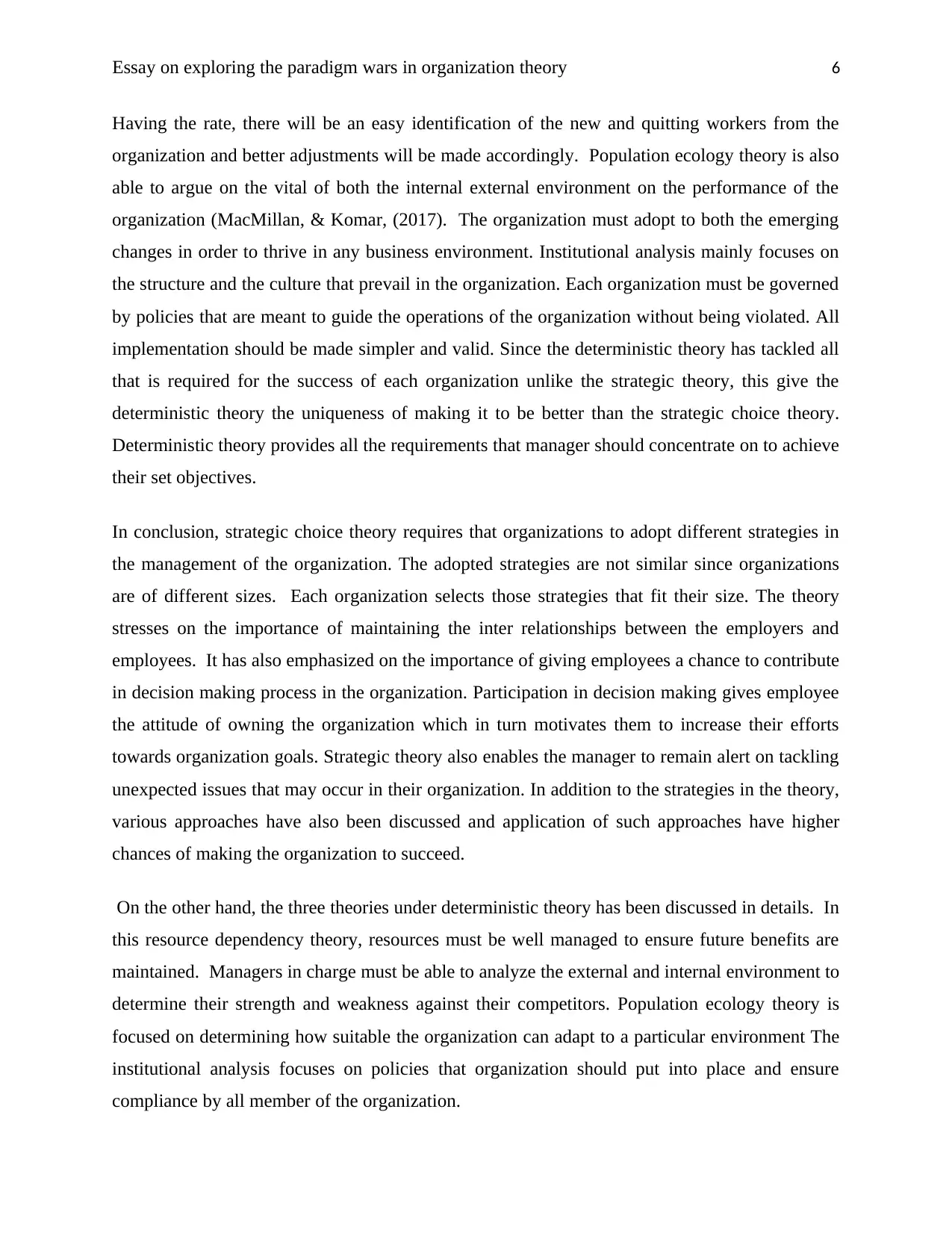
Essay on exploring the paradigm wars in organization theory 6
Having the rate, there will be an easy identification of the new and quitting workers from the
organization and better adjustments will be made accordingly. Population ecology theory is also
able to argue on the vital of both the internal external environment on the performance of the
organization (MacMillan, & Komar, (2017). The organization must adopt to both the emerging
changes in order to thrive in any business environment. Institutional analysis mainly focuses on
the structure and the culture that prevail in the organization. Each organization must be governed
by policies that are meant to guide the operations of the organization without being violated. All
implementation should be made simpler and valid. Since the deterministic theory has tackled all
that is required for the success of each organization unlike the strategic theory, this give the
deterministic theory the uniqueness of making it to be better than the strategic choice theory.
Deterministic theory provides all the requirements that manager should concentrate on to achieve
their set objectives.
In conclusion, strategic choice theory requires that organizations to adopt different strategies in
the management of the organization. The adopted strategies are not similar since organizations
are of different sizes. Each organization selects those strategies that fit their size. The theory
stresses on the importance of maintaining the inter relationships between the employers and
employees. It has also emphasized on the importance of giving employees a chance to contribute
in decision making process in the organization. Participation in decision making gives employee
the attitude of owning the organization which in turn motivates them to increase their efforts
towards organization goals. Strategic theory also enables the manager to remain alert on tackling
unexpected issues that may occur in their organization. In addition to the strategies in the theory,
various approaches have also been discussed and application of such approaches have higher
chances of making the organization to succeed.
On the other hand, the three theories under deterministic theory has been discussed in details. In
this resource dependency theory, resources must be well managed to ensure future benefits are
maintained. Managers in charge must be able to analyze the external and internal environment to
determine their strength and weakness against their competitors. Population ecology theory is
focused on determining how suitable the organization can adapt to a particular environment The
institutional analysis focuses on policies that organization should put into place and ensure
compliance by all member of the organization.
Having the rate, there will be an easy identification of the new and quitting workers from the
organization and better adjustments will be made accordingly. Population ecology theory is also
able to argue on the vital of both the internal external environment on the performance of the
organization (MacMillan, & Komar, (2017). The organization must adopt to both the emerging
changes in order to thrive in any business environment. Institutional analysis mainly focuses on
the structure and the culture that prevail in the organization. Each organization must be governed
by policies that are meant to guide the operations of the organization without being violated. All
implementation should be made simpler and valid. Since the deterministic theory has tackled all
that is required for the success of each organization unlike the strategic theory, this give the
deterministic theory the uniqueness of making it to be better than the strategic choice theory.
Deterministic theory provides all the requirements that manager should concentrate on to achieve
their set objectives.
In conclusion, strategic choice theory requires that organizations to adopt different strategies in
the management of the organization. The adopted strategies are not similar since organizations
are of different sizes. Each organization selects those strategies that fit their size. The theory
stresses on the importance of maintaining the inter relationships between the employers and
employees. It has also emphasized on the importance of giving employees a chance to contribute
in decision making process in the organization. Participation in decision making gives employee
the attitude of owning the organization which in turn motivates them to increase their efforts
towards organization goals. Strategic theory also enables the manager to remain alert on tackling
unexpected issues that may occur in their organization. In addition to the strategies in the theory,
various approaches have also been discussed and application of such approaches have higher
chances of making the organization to succeed.
On the other hand, the three theories under deterministic theory has been discussed in details. In
this resource dependency theory, resources must be well managed to ensure future benefits are
maintained. Managers in charge must be able to analyze the external and internal environment to
determine their strength and weakness against their competitors. Population ecology theory is
focused on determining how suitable the organization can adapt to a particular environment The
institutional analysis focuses on policies that organization should put into place and ensure
compliance by all member of the organization.
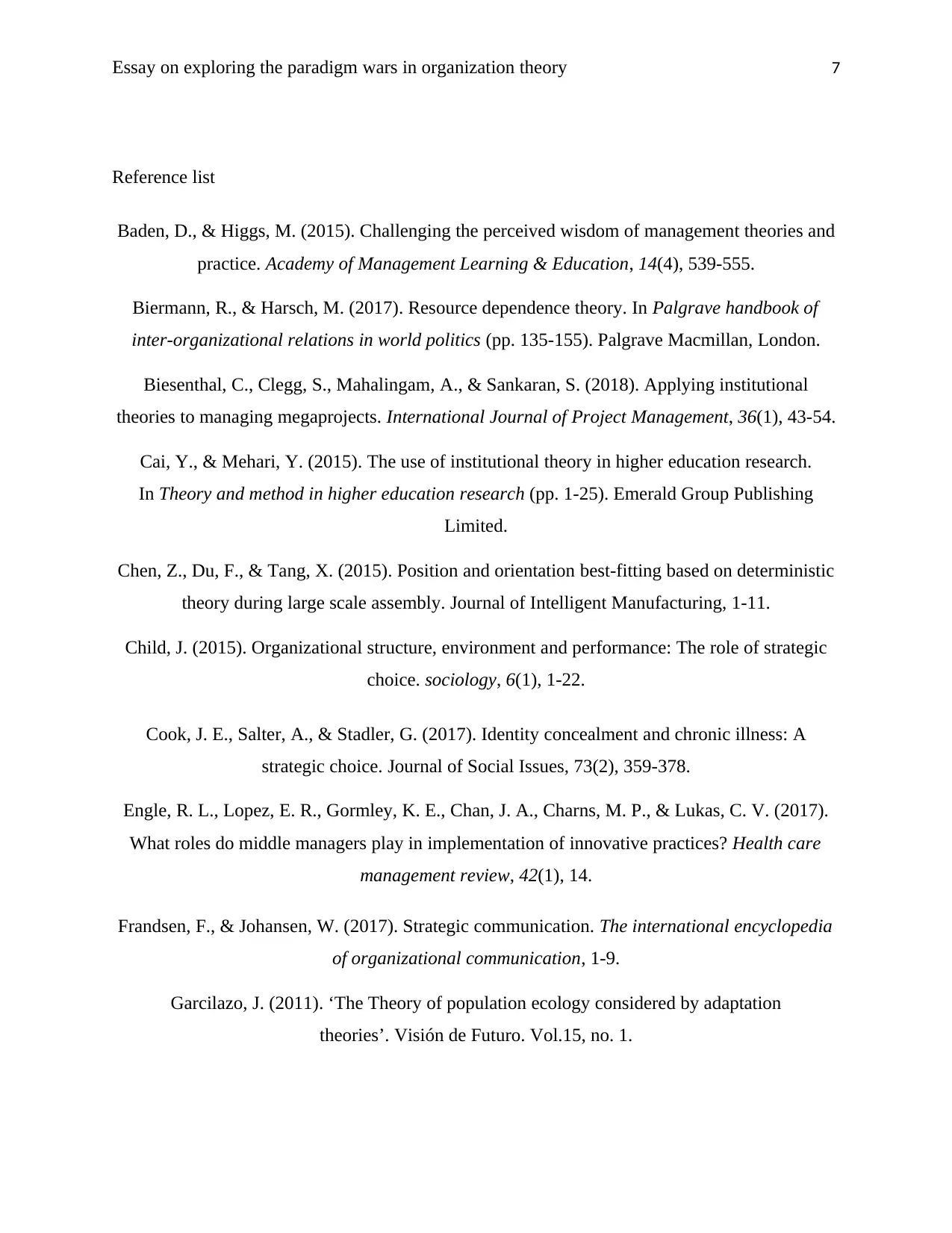
Essay on exploring the paradigm wars in organization theory 7
Reference list
Baden, D., & Higgs, M. (2015). Challenging the perceived wisdom of management theories and
practice. Academy of Management Learning & Education, 14(4), 539-555.
Biermann, R., & Harsch, M. (2017). Resource dependence theory. In Palgrave handbook of
inter-organizational relations in world politics (pp. 135-155). Palgrave Macmillan, London.
Biesenthal, C., Clegg, S., Mahalingam, A., & Sankaran, S. (2018). Applying institutional
theories to managing megaprojects. International Journal of Project Management, 36(1), 43-54.
Cai, Y., & Mehari, Y. (2015). The use of institutional theory in higher education research.
In Theory and method in higher education research (pp. 1-25). Emerald Group Publishing
Limited.
Chen, Z., Du, F., & Tang, X. (2015). Position and orientation best-fitting based on deterministic
theory during large scale assembly. Journal of Intelligent Manufacturing, 1-11.
Child, J. (2015). Organizational structure, environment and performance: The role of strategic
choice. sociology, 6(1), 1-22.
Cook, J. E., Salter, A., & Stadler, G. (2017). Identity concealment and chronic illness: A
strategic choice. Journal of Social Issues, 73(2), 359-378.
Engle, R. L., Lopez, E. R., Gormley, K. E., Chan, J. A., Charns, M. P., & Lukas, C. V. (2017).
What roles do middle managers play in implementation of innovative practices? Health care
management review, 42(1), 14.
Frandsen, F., & Johansen, W. (2017). Strategic communication. The international encyclopedia
of organizational communication, 1-9.
Garcilazo, J. (2011). ‘The Theory of population ecology considered by adaptation
theories’. Visión de Futuro. Vol.15, no. 1.
Reference list
Baden, D., & Higgs, M. (2015). Challenging the perceived wisdom of management theories and
practice. Academy of Management Learning & Education, 14(4), 539-555.
Biermann, R., & Harsch, M. (2017). Resource dependence theory. In Palgrave handbook of
inter-organizational relations in world politics (pp. 135-155). Palgrave Macmillan, London.
Biesenthal, C., Clegg, S., Mahalingam, A., & Sankaran, S. (2018). Applying institutional
theories to managing megaprojects. International Journal of Project Management, 36(1), 43-54.
Cai, Y., & Mehari, Y. (2015). The use of institutional theory in higher education research.
In Theory and method in higher education research (pp. 1-25). Emerald Group Publishing
Limited.
Chen, Z., Du, F., & Tang, X. (2015). Position and orientation best-fitting based on deterministic
theory during large scale assembly. Journal of Intelligent Manufacturing, 1-11.
Child, J. (2015). Organizational structure, environment and performance: The role of strategic
choice. sociology, 6(1), 1-22.
Cook, J. E., Salter, A., & Stadler, G. (2017). Identity concealment and chronic illness: A
strategic choice. Journal of Social Issues, 73(2), 359-378.
Engle, R. L., Lopez, E. R., Gormley, K. E., Chan, J. A., Charns, M. P., & Lukas, C. V. (2017).
What roles do middle managers play in implementation of innovative practices? Health care
management review, 42(1), 14.
Frandsen, F., & Johansen, W. (2017). Strategic communication. The international encyclopedia
of organizational communication, 1-9.
Garcilazo, J. (2011). ‘The Theory of population ecology considered by adaptation
theories’. Visión de Futuro. Vol.15, no. 1.
Paraphrase This Document
Need a fresh take? Get an instant paraphrase of this document with our AI Paraphraser
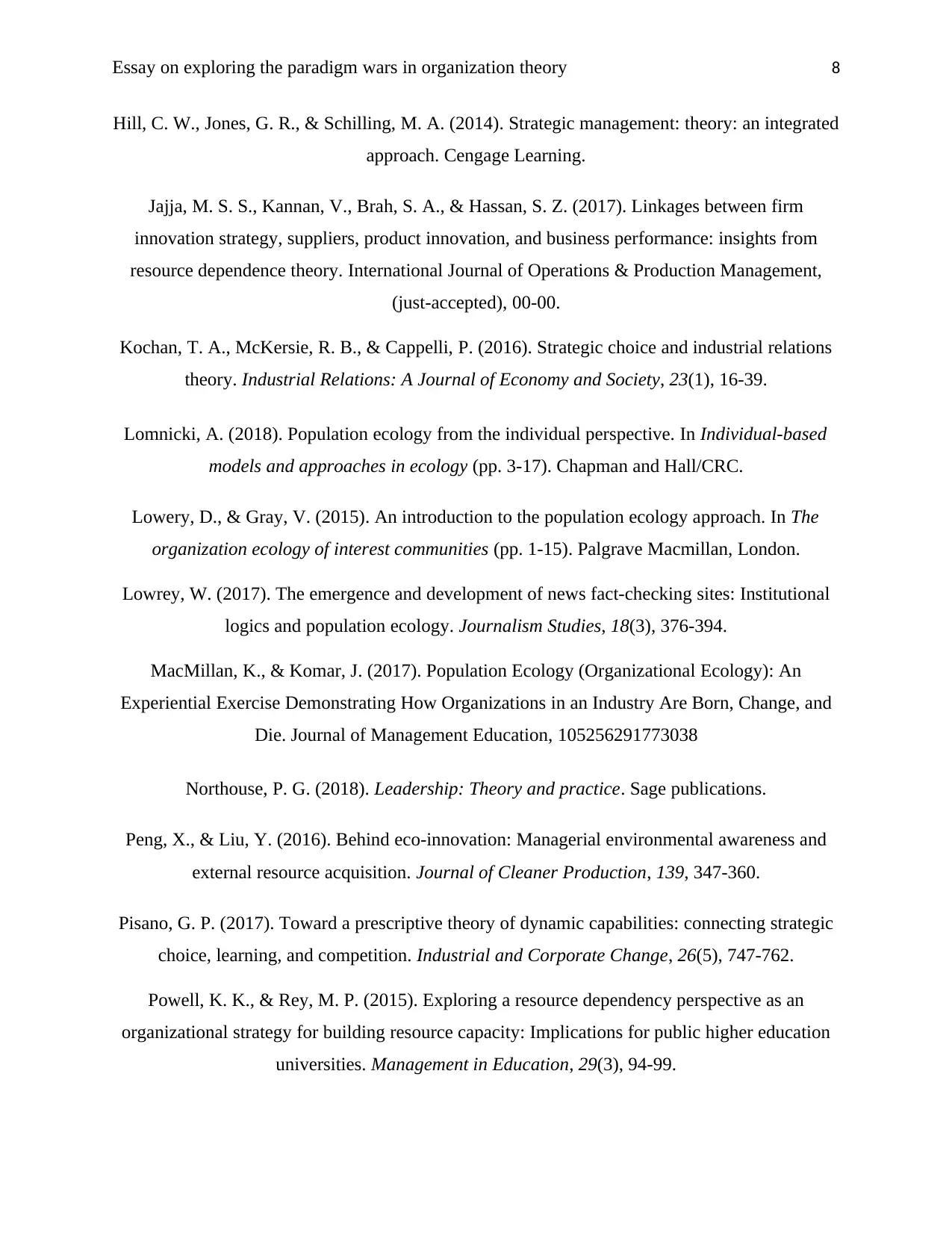
Essay on exploring the paradigm wars in organization theory 8
Hill, C. W., Jones, G. R., & Schilling, M. A. (2014). Strategic management: theory: an integrated
approach. Cengage Learning.
Jajja, M. S. S., Kannan, V., Brah, S. A., & Hassan, S. Z. (2017). Linkages between firm
innovation strategy, suppliers, product innovation, and business performance: insights from
resource dependence theory. International Journal of Operations & Production Management,
(just-accepted), 00-00.
Kochan, T. A., McKersie, R. B., & Cappelli, P. (2016). Strategic choice and industrial relations
theory. Industrial Relations: A Journal of Economy and Society, 23(1), 16-39.
Lomnicki, A. (2018). Population ecology from the individual perspective. In Individual-based
models and approaches in ecology (pp. 3-17). Chapman and Hall/CRC.
Lowery, D., & Gray, V. (2015). An introduction to the population ecology approach. In The
organization ecology of interest communities (pp. 1-15). Palgrave Macmillan, London.
Lowrey, W. (2017). The emergence and development of news fact-checking sites: Institutional
logics and population ecology. Journalism Studies, 18(3), 376-394.
MacMillan, K., & Komar, J. (2017). Population Ecology (Organizational Ecology): An
Experiential Exercise Demonstrating How Organizations in an Industry Are Born, Change, and
Die. Journal of Management Education, 105256291773038
Northouse, P. G. (2018). Leadership: Theory and practice. Sage publications.
Peng, X., & Liu, Y. (2016). Behind eco-innovation: Managerial environmental awareness and
external resource acquisition. Journal of Cleaner Production, 139, 347-360.
Pisano, G. P. (2017). Toward a prescriptive theory of dynamic capabilities: connecting strategic
choice, learning, and competition. Industrial and Corporate Change, 26(5), 747-762.
Powell, K. K., & Rey, M. P. (2015). Exploring a resource dependency perspective as an
organizational strategy for building resource capacity: Implications for public higher education
universities. Management in Education, 29(3), 94-99.
Hill, C. W., Jones, G. R., & Schilling, M. A. (2014). Strategic management: theory: an integrated
approach. Cengage Learning.
Jajja, M. S. S., Kannan, V., Brah, S. A., & Hassan, S. Z. (2017). Linkages between firm
innovation strategy, suppliers, product innovation, and business performance: insights from
resource dependence theory. International Journal of Operations & Production Management,
(just-accepted), 00-00.
Kochan, T. A., McKersie, R. B., & Cappelli, P. (2016). Strategic choice and industrial relations
theory. Industrial Relations: A Journal of Economy and Society, 23(1), 16-39.
Lomnicki, A. (2018). Population ecology from the individual perspective. In Individual-based
models and approaches in ecology (pp. 3-17). Chapman and Hall/CRC.
Lowery, D., & Gray, V. (2015). An introduction to the population ecology approach. In The
organization ecology of interest communities (pp. 1-15). Palgrave Macmillan, London.
Lowrey, W. (2017). The emergence and development of news fact-checking sites: Institutional
logics and population ecology. Journalism Studies, 18(3), 376-394.
MacMillan, K., & Komar, J. (2017). Population Ecology (Organizational Ecology): An
Experiential Exercise Demonstrating How Organizations in an Industry Are Born, Change, and
Die. Journal of Management Education, 105256291773038
Northouse, P. G. (2018). Leadership: Theory and practice. Sage publications.
Peng, X., & Liu, Y. (2016). Behind eco-innovation: Managerial environmental awareness and
external resource acquisition. Journal of Cleaner Production, 139, 347-360.
Pisano, G. P. (2017). Toward a prescriptive theory of dynamic capabilities: connecting strategic
choice, learning, and competition. Industrial and Corporate Change, 26(5), 747-762.
Powell, K. K., & Rey, M. P. (2015). Exploring a resource dependency perspective as an
organizational strategy for building resource capacity: Implications for public higher education
universities. Management in Education, 29(3), 94-99.
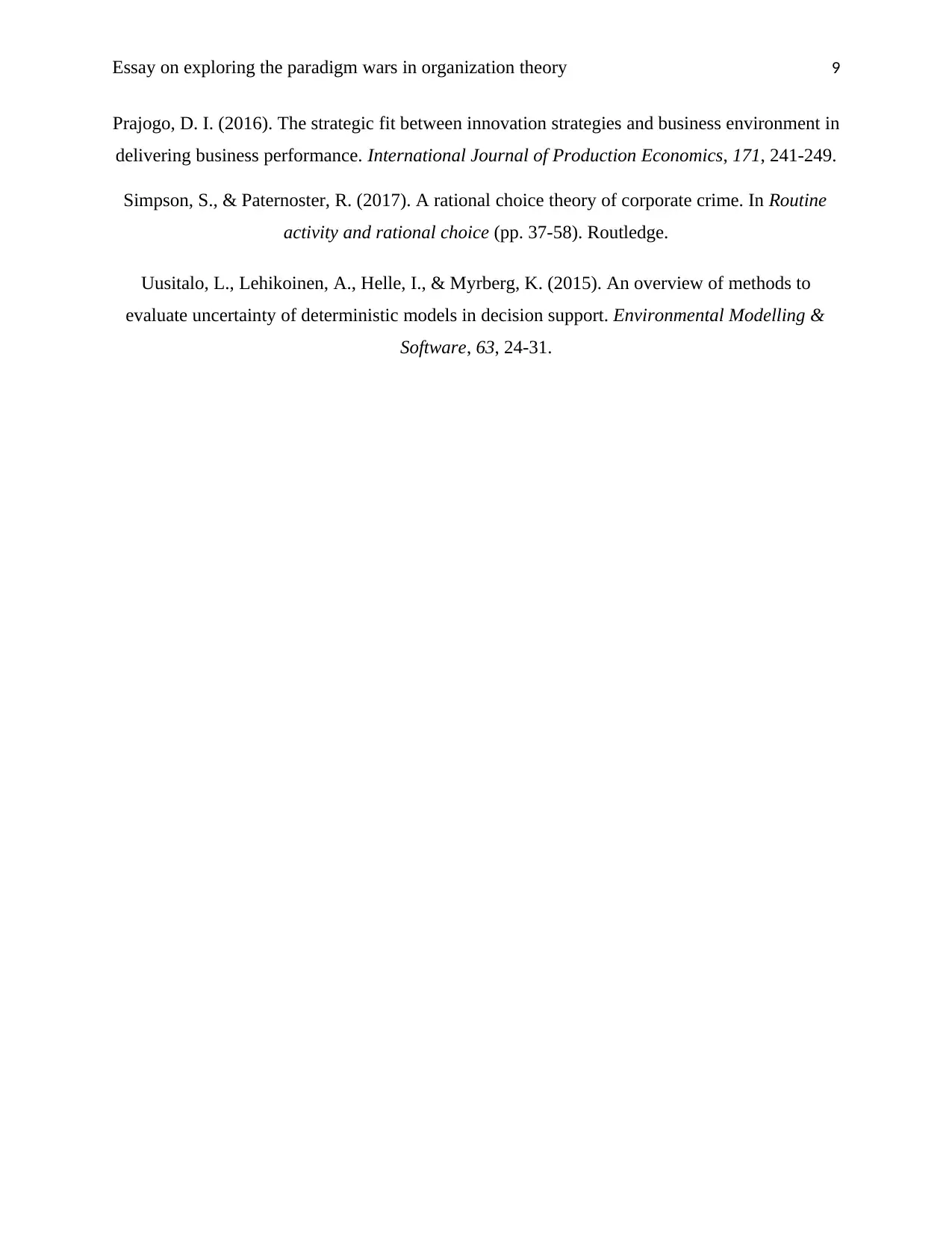
Essay on exploring the paradigm wars in organization theory 9
Prajogo, D. I. (2016). The strategic fit between innovation strategies and business environment in
delivering business performance. International Journal of Production Economics, 171, 241-249.
Simpson, S., & Paternoster, R. (2017). A rational choice theory of corporate crime. In Routine
activity and rational choice (pp. 37-58). Routledge.
Uusitalo, L., Lehikoinen, A., Helle, I., & Myrberg, K. (2015). An overview of methods to
evaluate uncertainty of deterministic models in decision support. Environmental Modelling &
Software, 63, 24-31.
Prajogo, D. I. (2016). The strategic fit between innovation strategies and business environment in
delivering business performance. International Journal of Production Economics, 171, 241-249.
Simpson, S., & Paternoster, R. (2017). A rational choice theory of corporate crime. In Routine
activity and rational choice (pp. 37-58). Routledge.
Uusitalo, L., Lehikoinen, A., Helle, I., & Myrberg, K. (2015). An overview of methods to
evaluate uncertainty of deterministic models in decision support. Environmental Modelling &
Software, 63, 24-31.
1 out of 9
Related Documents
Your All-in-One AI-Powered Toolkit for Academic Success.
+13062052269
info@desklib.com
Available 24*7 on WhatsApp / Email
![[object Object]](/_next/static/media/star-bottom.7253800d.svg)
Unlock your academic potential
© 2024 | Zucol Services PVT LTD | All rights reserved.




